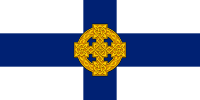
The Flag of the Church in Wales is the flag used to represent the Church in Wales. It consists of a blue cross on a white background with a gold celtic cross in the centre. It was adopted in 1954 by the Governing Body of the Church in Wales.

The Flag of the Church in Wales is the flag used to represent the Church in Wales. It consists of a blue cross on a white background with a gold celtic cross in the centre. It was adopted in 1954 by the Governing Body of the Church in Wales.

Prior to its disestablishment in 1920, the Anglican Church in Wales was a part of the Church of England. The flag used to represent the church was the Saint George's Cross, the same as the Church of England. Following the Welsh Church Act 1914, the Church in Wales was disestablished and separated from the Church of England. In the 1930s, the Church of England started to fly flags of England with the coat of arms of the respective diocese in the upper left of the flag. This practice became popular and was adopted by the Church in Wales unofficially using a flag of Saint David with the colours reversed in place of the Saint George's Cross. [1]
In 1954 the Church in Wales' governing body passed a motion for an official flag to represent the church. Following negotiations with the College of Arms, it was decided that the new flag would consist of a blue cross with a white background with a gold celtic cross in the centre. [1] The flag gained official status on 9 December 1954. [1]
The official grant of arms defines the flag as "Argent, on a Cross Azure a Celtic Cross Or". There have been differences in the celtic cross in the flag with versions where the cross has the spaces within it filled with gold rather than showing the blue of the cross. [2] As a flag for the Welsh made separate from England, the flag of the Church in Wales is viewed as a uniquely Welsh flag. [3] Churches can use the flag, or the flag of their diocese. [3]
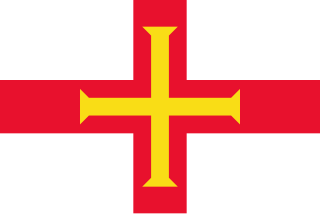
The flag of Guernsey was adopted in 1985 and consists of the red Saint George's Cross with an additional gold Norman cross within it. The creation was prompted by confusion at international sporting events over competitors from Guernsey and England using the same flag. It was designed by the Guernsey Flag Investigation Committee led by Deputy Bailiff Sir Graham Dorey. The flag was first unveiled on the island on 15 February 1985. The gold cross represents William the Bastard, Duke of Normandy. William purportedly was given such a cross by Pope Alexander II and flew it on his standard in the Battle of Hastings. Since 2000, a red ensign with the cross in the fly has been used as the government's civil ensign and as a blue ensign.

The flag of England is the national flag of England, a constituent country of the United Kingdom. It is derived from Saint George's Cross. The association of the red cross as an emblem of England can be traced back to the Late Middle Ages when it was gradually, increasingly, used alongside the Royal Banner. It became the only saint's flag permitted to be flown in public as part of the English Reformation and at a similar time became the pre-eminent maritime flag referred to as a white ensign. It was used as a component in the design of the Union Jack in 1606.
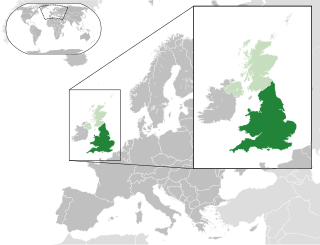
England and Wales is one of the three legal jurisdictions of the United Kingdom. It covers the constituent countries England and Wales and was formed by the Laws in Wales Acts 1535 and 1542. The substantive law of the jurisdiction is English law.
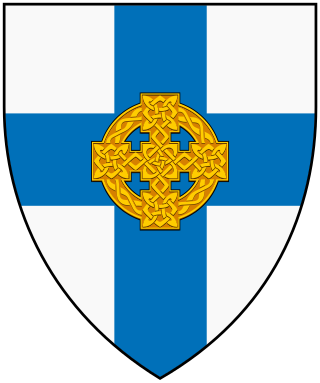
The Church in Wales is an Anglican church in Wales, composed of six dioceses.

The flag of Wales consists of a red dragon passant on a green and white field. As with many heraldic charges, the exact representation of the dragon is not standardised and many renderings exist. It is not represented in the Union Flag.

The coat of arms of Ireland is blazoned as Azure a harp Or, stringed Argent. These arms have long been Ireland's heraldic emblem. References to them as being the arms of the king of Ireland can be found as early as the 13th century. These arms were adopted by Henry VIII of England when he ended the period of Lordship of Ireland and declared Ireland to be a kingdom again in 1541. When the crowns of England, Scotland and Ireland were united in 1603, they were integrated into the unified royal coat of arms of kingdoms of England, Scotland and Ireland. The harp was adopted as the emblem of the Irish Free State when it separated from the United Kingdom in 1922. They were registered as the arms of Ireland with the Chief Herald of Ireland on 9 November 1945.
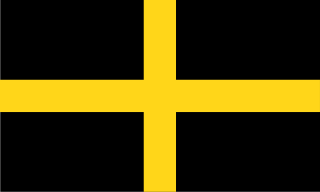
The flag of Saint David is normally a yellow cross on a black field, but it has also appeared as a black cross on a yellow field or with an engrailed cross. It represents the 6th-century Saint David, a Welsh bishop of Menevia and the patron saint of Wales.

Saint Patrick's Saltire or Saint Patrick's Cross is a red saltire on a white field. In heraldic language, it may be blazoned "argent, a saltire gules". The Saint Patrick's Flag is a flag composed of Saint Patrick's Saltire. The origin of the saltire is disputed. Its association with Saint Patrick dates from the 1780s, when the Anglo-Irish Order of Saint Patrick adopted it as an emblem. This was a British chivalric order established in 1783 by George III. It has been suggested that it derives from the arms of the powerful Geraldine or FitzGerald dynasty. Most Irish nationalists and others reject its use to represent Ireland as a "British invention" "for a people who had never used it".

Religion in Wales has, over the years, become increasingly diverse. Christianity was the religion of virtually all of the Welsh population until the late 20th century, but it has rapidly declined throughout the early 21st century. Today a plurality of people in Wales follow no religion at all.

The national symbols of Wales include various official and unofficial images and other symbols.

Many different symbols are associated with Cornwall, a region which has disputed constitutional status within the United Kingdom . Saint Piran's Flag, a white cross on a black background is often seen in Cornwall. The Duchy of Cornwall shield of 15 gold bezants on a black field is also used. Because of these two symbols black, white and gold are considered colours symbolic of Cornwall.
Christianity is the majority religion in Wales. From 1534 until 1920 the established church was the Church of England, but this was disestablished in Wales in 1920, becoming the still Anglican but self-governing Church in Wales. Wales also has a strong tradition of nonconformism and Methodism.
The Representative Body of the Church in Wales is a registered charity, regulated by the Charity Commission for England and Wales, responsible for holding property and assets on behalf of the Church in Wales. It was set up in 1917 to oversee the financial arrangements of the new province of the Anglican Communion when the Church in Wales split off from the Church of England in 1920.

St. Peter's Church is a Church of England parish church at Dixton. It is situated on the banks of the River Wye, about 1 mile (1.6 km) north-east of Monmouth, Wales. The church is a Grade II* listed building and the cross in the churchyard is both a listed building and a scheduled monument.
The Governing Body of the Church in Wales is the deliberative and legislative body of the Church in Wales, broadly speaking equivalent to the General Synod of the Church of England. The Governing Body usually meets twice each year to receive reports, discuss issues concerning the church and make decisions on matters brought before it.

The Church of England border polls 1915–1916 were a series of referendums held in January and February 1915, for residents of living in nineteen Church of England ecclesiastical parishes, the boundaries of which crossed the England–Wales border. They were carried out to determine if the parish residents wished their parish to remain part of the Church of England or to become part of the Church in Wales when the Welsh Church Act 1914 took effect.. The polls eventually resulted in all but one of the border parishes voting to remain with the Church of England.

St Silin's Church is a parish church in Llansilin, Powys, Wales. The present building, which has parts dating back to the 13th century, is a Grade I listed building. It stands on a site that has been used by Christian communities since the Dark Ages. The church is dedicated to Saint Silin, now better known as Saint Sulien, the 6th-century founder-abbot of a monastery at Luxulyan in Cornwall.
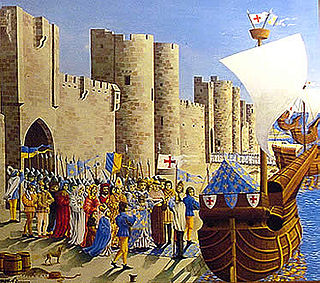
The history of Christian flags encompasses the establishment of Christian states, the Crusader era, and the 20th century ecumenical movement.
The Welsh Church Commissioners were set up by the Welsh Church Act 1914 to deal with the disendowment of the Church of England in Wales, as part of its disestablishment. Their task was to ascertain which ecclesiastical assets the future Church in Wales should retain, and which should be transferred to local authorities, and to various Welsh national institutions. They were required to transfer those assets which the Church in Wales was entitled to retain to the Representative Body of the Church in Wales. The remaining assets were to be transferred to the thirteen County Councils and four County Borough Councils which existed in Wales until 1974, and to the University of Wales and its constituent colleges. For various reasons which are explained below, the process took considerably longer than was first envisaged. The Commissioners could not ultimately be wound up until 1947. The assets transferred constituted the "Welsh Church Act Funds" of the respective institutions. The County and County Borough Councils hold the funds for charitable and other purposes. The funds are still in existence. As part of their responsibilities, the Welsh Church Commissioners also organised the border polls which were held in 1915 in parishes which straddled the administrative border between England and Wales.